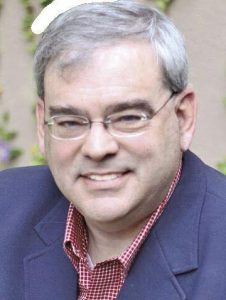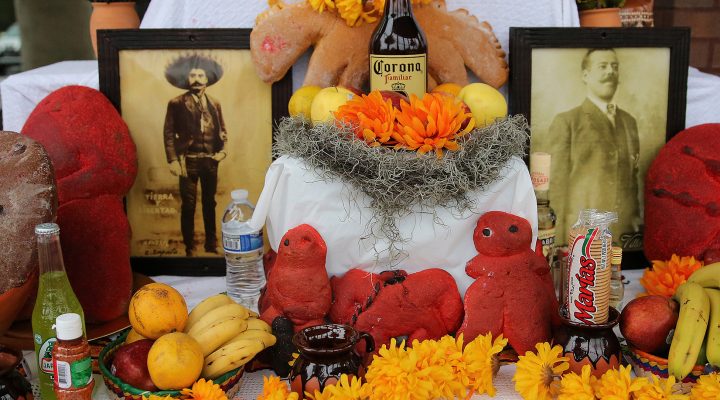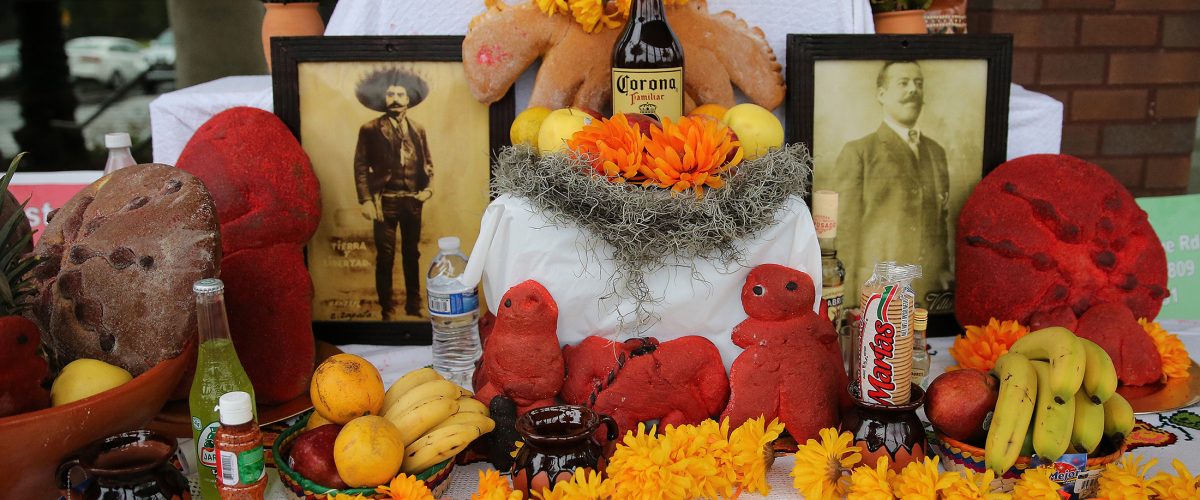Several months ago, while perusing the aisles of Home Goods, I noticed a discreet display of party items for El Dia de los Muertos, the Day of the Dead, observed annually on Nov. 2. If Michael’s can haul out the holly in July, why not Day of the Dead decor at the end of August?
Funky, multi-colored skulls, brightly colored tissue paper banners, marigold-embossed plates, napkins and cups, and scented candles made up the display. Small because, with the exception of Latino friends, most folks in my neck of the North Carolina woods have little to no idea what the day is about, much less the importance of the celebration in other cultures.
El Dia de los Muertos coincides with and finds its roots in the Christian observance of All Saints and All Souls Day, the days following Halloween or All Hallows Eve. My only experience growing up, and into adulthood, was with the latter. The candy and costumes of childhood morphed into teenage mischief and pranks, which got me grounded on two occasions — once for shooting off bottle rockets in a cemetery, where family members were buried.
The Day of the Dead, like Christmas and Easter, has ancient European pagan origins, with some traditions eventually Christianized and (reluctantly) allowed by the Catholic Church. Spanish conquistadors brought the faith and corresponding traditions to the New World. Short life spans, made even shorter by bubonic plague, perhaps instilled a desire to find some glimpse of hope and joy after such a dark and deadly season.

Tom Allen
Those of Mexican ancestry brought Day of the Dead celebrations to the U.S. Observances grew over the years, with homes, graves and even churches displaying “altars” adorned with pictures of deceased loved ones, colorful banners, crosses, candles, decorative skulls, and chrysanthemums (the aroma is supposed to help the deceased spirits find their way back to earth, if only for a day). Bread, or pan de muerto, along with the departed’s favorite foods, also are offered.
Growing up in the South and in Eastern North Carolina, I was taught cemeteries were hallowed grounds. When you visited, you were quiet, reverent, and you trod gingerly. “Don’t step on that grave,” my mother chided. (How can you not step on a grave in a graveyard?) My dad was a member of a Ruritan club, the affiliate of a national, rural civic club. Ruritans made sure our two community graveyards were mowed, at times even restoring aged, broken gravestones. Lovingly, they still do.
My mom always brought flowers to decorate the graves of family members at Christmas and Easter, their plastic or silk petals eventually blistered by the sun or blown away by storms. But the point was to remember, to leave some visible symbol that someone who cared had been there, to simply honor the fact the deceased lived and loved and mattered.
But I’m not sure Mom would have embraced Dia de los Muertos. Many who observe the tradition descend on family cemeteries to clean graves and scour headstones. Some remain to pray in silence, but many, after the cleanup, do anything but mourn and remain silent. They bring flowers, sing, dance, eat and drink. Cue the mariachi music. They tell stories. They laugh. They acknowledge that death is a part of life but affirm that heaven might be a little closer to earth than others might realize and that the deceased may come to visit, if only for a while.
After my parents died and their house was emptied and readied for the young couple who would purchase it, my wife, two daughters and I gathered one last time in that empty house. We spread one of my mom’s crazy quilts and had a meal of hot dogs and fries from “The Grill” across from my folks’ house, a beloved community kitchen my parents frequently patronized. We cried a little, laughed a lot, then shut the door, one final time, on that space and its memories.
“I do wonder if the occasional pull-out-all-the-stops celebration of lives past but absent might cushion our sadness and buoy our spirits.”
We stopped by the cemetery and visited their graves, recalling long lives and a deep love, especially for their two granddaughters. No surprise that when our girls married, they asked that their bouquets be left at their grandparents’ graves.
While Day of the Dead rituals may not be how many choose to remember the departed during the first days of November, I do wonder if the occasional pull-out-all-the-stops celebration of lives past but absent, whenever and wherever it takes place, might cushion our sadness and buoy our spirits. I think my mother would frown at shagging to beach music on her grave, but she loved a good glass of champagne. I don’t think she’d mind a toast to her good life. And my dad? A gardener, he would smile if someone enjoyed a homegrown tomato sandwich at his final resting place, especially a Purple Cherokee, from that last vine to squeeze out fruit before the first frost.
This year, sometime during the first week of November, I’ll visit my parents’ graves, along with those of other family members and friends who rest in the rural cemetery of my childhood hamlet. I’ll pass on praying for “the poor souls in purgatory,” as some Catholic friends do on this holy day. I’m at peace knowing my folks, and all those I’ve loved who died believing, are in good hands.
I’ll also visit another grave. Tim, one of my best friends from childhood, was struck and killed by a car while taking his trash to the curb on a rainy evening last August. Three days later, still in shock, I officiated his funeral in the church of our childhood, filled with his family and friends, many of those high school classmates. Retired after a career in the prison system, Tim was a compassionate worker with those who were incarcerated. He also was a gifted musician, a piano player with a quick, sometimes irreverent wit. He was a good husband, beloved stepdad and Papa Tim to his wife’s kids and grands, a gregarious soul who never met a stranger. The last time we hung out was over Eastern North Carolina barbeque, at a hole-in-the-wall where the tea is as sweet as the folks who’ve worked there forever.
Who knows? This All Souls Day, you may find me sitting by my folks’ graves, noshing on an “all the way” hot dog, smiling over the memories, singing their favorite hymns. And maybe I’ll remember Tim by raising a Styrofoam cup of sweet tea by his grave, sweet tea that’s poured over soft crushed ice, the kind that doesn’t melt in your mouth too fast, the kind you can savor while you both grieve and give thanks.
If you see me eating, singing or even dancing, don’t think I’m daft. Come, sit down and join the party. Heaven might just be closer to earth than you think.
Tom Allen retired as minister of education at First Baptist Church, Southern Pines, N.C.
Related articles:
Abiding in thin places: Día de los Muertos and lessons from loved ones passed | Opinion by Paula Mangum Sheridan
On All Saints Day and Thanksgiving: ‘Hey, … me too!’ | Opinion by Charles Qualls


